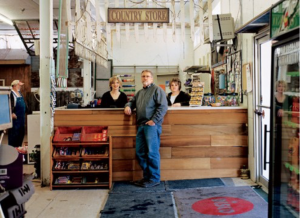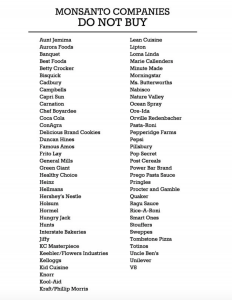The Root of the Problem: A Look into Monsanto Co.
Genetically Modified Organisms (GMOs) are defined as “organisms in which genetic material (DNA) has been altered in a way that does not occur naturally by mating and/or natural recombination” (WHO). In our current climate, there is widespread debate not only in the realm of if these GMOs have benefitted our planet in the aspects of long-term food production, yield, health, and more but also as to whether or not they should even be allowed.

Source: Organics
At the core of the controversy surrounding them is a certain company called Monsanto. Founded in 1901 as a chemical company, Monsanto found its claim to fame (or more poignantly, infamy) by innovating the agribusiness/biotechnology sphere in the 1980s by changing the genetic makeup of plant cells. They have pushed to make seeds that are resistant to pesticides, grow bigger fruits and vegetables, add supplemental nutrients, delay the ripening process, and more in an effort to revolutionize the age-old techniques of farming (Bruso). Yet, not surprisingly, this “innovation” has led to a plethora of problems currently plaguing not only the farming industry, but our society as a whole. The use of legal power to overrun farmers, an enormous yearly revenue to buy out competitors, and inherent dangerous effects of their chemical imprint has led to a scorched trail of health problems, harmful environmental impacts, and jobless farmers in its path. The following analysis will point to the root of these issues and a give a detailed look as to what impact it has had on our society.
One of the primary notions leading to the controversy surround Monsanto is the ruthless strong-arming and lobbying that the company has used in order to pursue their own revenue-driven agenda. The U.S. Department of Agriculture estimated that in 2016, 94% of soybean acres and 92% of corn acres were planted with biotech varieties—Monsanto owns 90% of the market share in those sectors (Bunge). They then use this to drive a $13.5 billion a year revenue to increasingly raise prices of their seeds and drive organic farmers into bankruptcy if they cannot afford the hikes. With this in mind, one might be curious as to why farmers buy into the model of using the genetically modified seeds in the first place, being as though almost all seeds used today in the U.S. are genetically modified. The answer lies in the fact that these seeds not only provide for increased crop yields due to the incredibly detailed way in which they were engineering, but also the fact that it is an enormous convenience to farmers to use “Round-Up Ready seeds” as they are resistant to many pesticides.


Source: NY Times
Farmers simply have to plant the seed and spray the chemicals on their crops, killing everything in its way besides the plant itself. Yet, many farmers today cannot buy the seeds as they have become far too expensive to purchase as crop prices continually decrease overtime.

Source: Wall Street Journal
It is a problem likened to the Epipen today, as these seeds often times are viewed as a necessity to make a living, but many farmers can simply not afford them at the price they are at today.
Now if you just so happen to have these seeds on your land without having a costly and exclusive contract with Monsanto, rest-assured there will be a powerful force of private investigators (or the “seed police” as they are colloquially called by farmers), lawyers, and more coming for your small operation. Take for instance Gary Rinehart. In 2002, he was visited by one of these Monsanto cronies at his general store that he owns in the 350-person town of Eagleville, Missouri. The man asked why he was illegally using Monsanto-patented genetically modified seeds for his farm, when Rinehart in fact was doing no such thing. Yet, Rinehart was still brought to court, forced to hire a lawyer, pay exorbitant fees, all to have the case dropped as it was clear no foul-play was at work. And in the end, Rinehart was left with an incredibly expensive bill, detracting from his livelihood as he was working hard to maintain his store, whereas for Monsanto, this was just another day’s work in which thousands of farmers just like him are being persecuted (Barlett and Steele).

Source: Vanity Fair
The concept of patenting seeds in and of itself is far-fetched, as for “nearly all of its history the United States Patent and Trademark Office had refused to grant patents on seeds, viewing them as life-forms with too many variables to be patented” (Barlett and Steele). However, in 1980, the U.S. Supreme Court ruled in a five-to-four decision to change the classification of seeds into widgets, thus opening the door for Monsanto and other companies to exploit this and patent their own technology surrounding them. (Barlett and Steele).
However, even though Monsanto may make GMOs, they do not want consumers to know that the food that they are eating has been genetically modified. The case of Proposition 37 in California, which proposed “to label all GMO foods, including processed foods that contain GMO ingredients, to prevent GMO foods from being labeled or advertised as ‘natural’” is a good example (Frostenson). Agriculture company giants funded a massive resistance to defeat the proposition from Monsanto leading the way to Pespi Co., Nestle, and more all contributing huge sums.

Source: Sunlight Foundation
Monsanto and friends are so large and have so much cash flow that they can simply lobby politicians to get their way in most every scenario that benefits them. By referencing the aforementioned statistic that Monsanto owns 90% of all GMOs, they essentially control the food supply for the U.S. They are able to control what type of food is planted in terms of how the seeds are genetically modified, they control who has the rights to use their seeds, and they can lobby to control the labeling (rather selective mislabeling) of the food that their seeds produce. And if all the above does not work to stop their competitors and opposition, Monsanto can and will buy them. In 2005, Monsanto “paid $1.4 billion for Seminis, which controlled 40% of the U.S. market for lettuce, tomatoes, and other vegetable and fruit seeds” (Barlett and Steele). Then two weeks after that, it bought out Emergent Genetics (third-largest cottonseed company) for another $300 million. They have put such a stronghold on the market for GMOs, unlike any other company in any other industry. And with a market capitalization of $50.66 billion, it makes them one of the largest companies in the world regardless of industry. A long history of mergers and acquisitions activity, coupled with future interests could “lift the new value [of Monsanto] to more than $100 billion” effectively giving them the monopolistic power to acquire and eliminate any and all competition in their way (Hakim).
Furthermore, the use of harmful chemicals on Monsanto’s part negatively impacts the environment and people alike. One such instance of the type of environmental detriment that Monsanto has caused can be seen with Colony Collapse Disorder (CCD) among bee populations. The benefits bees have to the food supply cannot be understated. Many of our fruits, vegetables, and more are reliant on bees pollinating them so that they can grow with the proper nutrients, something that is a problem if bee colonies are collapsing. True to fashion of eliminating opposition, Monsanto acquired a company called Beelogics whose primary focus is to combat and control Colony Collapse Disorder (Alliance for Natural Health). Monsanto’s use of pesticides has been linked to CCD in many instances, yet the overwhelming power that they have always finds a way to subvert this.

Source: NY Times
For example, organic beekeeper Terry Ingram had a catalog of fifteen years of research backing his claim that “Round-Up Ready” crops were causing CCD. However, when he asked the Illinois Department of Agriculture to test one of his honeycombs because the bees would not go near it, they did not test for chemicals, rather “foulbrood, a disease that affects bee larvae” and followed that up by confiscating every piece of bee equipment that he had, including the bees themselves. They destroyed all his evidence in the process as well (Alliance for Natural Health).
Another such reference comes on March 8, 1949 in which Monsanto’s plant in Nitro, West Virginia exploded, sending tons of chemical vapor into the air, covering the surrounding town (Barlett and Steele). This chemical, known as dioxin, has been classified by the International Agency for Research on Cancer as a “known human carcinogen”. Workers and citizens across the town had skin eruptions within days following the explosion, pointing to the dangerous effects that the chemicals Monsanto is putting in the food that we eat can cause. Monsanto is even in the pockets of the Environmental Protection Agency when it comes to health concerns as a recent court filing on the behalf of a number of people claiming that Monsanto’s Roundup gave them cancer details how the EPA is reportedly colluding with Monsanto (Gillam). The claim is that top-ranking EPA official Jess Rowland “who oversees the EPA’s cancer assessment for glyphosate, the key ingredient in Monsanto’s weed-killing products, is a key author of a report finding glyphosate was not likely to be carcinogenic” and is using this to work with Monsanto to help them in their legal battle. There is even direct discord in the EPA, as toxicologist Marion Copley cites evidence from previous animal studies that “he is almost certain that glyphosate causes cancer” (Gillam). It abundantly clear that the chemicals that Monsanto uses in its products we have most definitely encountered are harmful to not only humans but the environment as a whole, yet once again with enough power (read: money) they can change the rhetoric to further their cause.
In terms of solutions for combatting Monsanto, there have been numerous rallies and organizations formed attempting to stop the agrochemical giant. However, Monsanto actually believes that it can change the perception of its own company by future innovations that they will try and introduce. One of these being an “RNA spray”, which is supposed to kill harmful pests that destroy crop fields and “be no more harmful than orange juice to humans” (Regalado). Yet, just like with anything Monsanto does, their biggest battle is from a public relations standpoint. As Regalado put it, “the real problem can be summarized in a single word: Monsanto. For half the world, that is enough to know it’s evil. But Monsanto is also the best way to make this real. For the scientifically literate, this is the dream molecule.” There is some merit in trying to push the boundaries and make good on decades of turmoil that has been caused, but unfortunately this is still not a reality in its current state. In addition to supporting organizations that fight Monsanto and the injustices that they bring upon farmers, everyday citizens, and the environment every day, you can make an impact by simply boycotting the Monsanto line of products.

Source: Organics
Currently, this is the best way to advocate against the company as the only way to fight a company that’s only concern is money is to take that away from them. And consumers around the world have the power to do just that.